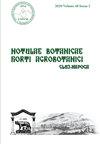番茄作物中霉菌病原体的生态控制--合成杀虫剂的替代品
IF 1.3
4区 生物学
Q3 PLANT SCIENCES
引用次数: 0
摘要
从病原体的角度来看,番茄栽培中的病原体 Alternaria solani 和 Fusarium oxysporum f. sp. lycopersici 具有重大意义。本研究的重点是评估不同合成物质和天然化合物对这两种病原体发展的杀菌和抑菌作用。采用的杀菌剂包括浓度为 0.3% 的福赛铝,浓度为 0.2% 的唑螨酯和浓度为 0.3% 的甲螨嗪,而调查的天然提取物包括从欧洲生草、白屈菜和鼠尾草中提取的提取物,每种提取物的测试浓度分别为 0.5%、2%、9% 和 15%。菌丝生长抑制评估采用文森特公式进行。此外,按照 Frum 等人(2022 年)的方法,通过 Folin-Ciocalteu 分光光度法测定了提取物中的总多酚含量(TPC)。此外,还使用 DPPH 自由基清除法(2,2-二苯基-1-苦基肼)和高效液相色谱法(HPLC)评估了提取物的抗氧化能力。我们的研究结果值得注意,特别是从鼠尾草和白屈菜中提取的提取物,尤其是浓度为 15%的提取物,具有抗真菌作用。与浓度为 0.2% 的合成杀菌剂唑啉草酯相比,这种效果在受到 Alternaria 病原体挑战时尤为显著。这些结果表明,鼠尾草和白屈菜提取物作为减轻番茄作物中真菌病原体的生态友好型替代品具有潜在的效用,值得在农业实践中进一步研究和考虑。本文章由计算机程序翻译,如有差异,请以英文原文为准。
Ecological control of mycotic pathogens in tomato crops - alternatives to synthetic pesticides
The pathogens Alternaria solani and Fusarium oxysporum f. sp. lycopersici are of significant interest from a pathogenic perspective in the context of tomato cultivation. This study focuses on evaluating the fungicidal and fungistatic effects of different synthetic substances and natural compounds on the development of these two investigated pathogens. The fungicidal agents employed comprised fosetyl aluminum at a concentration of 0.3%, azoxystrobin at 0.2%, and metiram at 0.3%, while the natural extracts investigated included those derived from European birthwort, celandine and sage, each tested at concentrations of 0.5%, 2%, 9%, and 15%. The assessment of mycelial growth inhibition was conducted utilizing Vincent’s formula. Additionally, the total polyphenol content (TPC) within the extracts was determined via the Folin-Ciocalteu spectrophotometric method in accordance with Frum et al. (2022). Furthermore, the antioxidant capacity of the extracts was evaluated using the DPPH radical scavenging method (2,2-diphenyl-1-picrylhydrazyl) and high-performance liquid chromatography (HPLC). Our research findings yielded noteworthy results, specifically, extracts derived from sage and celandine, particularly when present at a concentration of 15%, exhibited a fungistatic effect. This effect was particularly remarkable when compared to the performance of the synthetic fungicide azoxystrobin at a concentration of 0.2% when challenged with the Alternaria pathogen. These results suggest the potential utility of sage and celandine extracts as eco-friendly alternatives for mitigating fungal pathogens in tomato crops, warranting further investigation and consideration within agricultural practices.
求助全文
通过发布文献求助,成功后即可免费获取论文全文。
去求助
来源期刊

Notulae Botanicae Horti Agrobotanici Cluj-napoca
PLANT SCIENCES-
CiteScore
2.70
自引率
0.00%
发文量
118
审稿时长
3 months
期刊介绍:
Notulae Botanicae Horti Agrobotanici Cluj-Napoca is a peer-reviewed biannual journal aimed at disseminating significant research and original papers, critical reviews and short reviews. The subjects refer on plant biodiversity, genetics and plant breeding, development of new methodologies that can be of interest to a wide audience of plant scientists in all areas of plant biology, agriculture, horticulture and forestry. The journal encourages authors to frame their research questions and discuss their results in terms of the major questions of plant sciences, thereby maximizing the impact and value of their research, and thus in favor of spreading their studies outcome. The papers must be of potential interest to a significant number of scientists and, if specific to a local situation, must be relevant to a wide body of knowledge in life sciences. Articles should make a significant contribution to the advancement of knowledge or toward a better understanding of existing biological and agricultural concepts. An international Editorial Board advises the journal. The total content of the journal may be used for educational, non-profit purposes without regard to copyright. The distribution of the material is encouraged with the condition that the authors and the source (Notulae Botanicae Horti Agrobotanici Cluj-Napoca or JCR abbrev. title Not Bot Horti Agrobo) are mentioned.
 求助内容:
求助内容: 应助结果提醒方式:
应助结果提醒方式:


